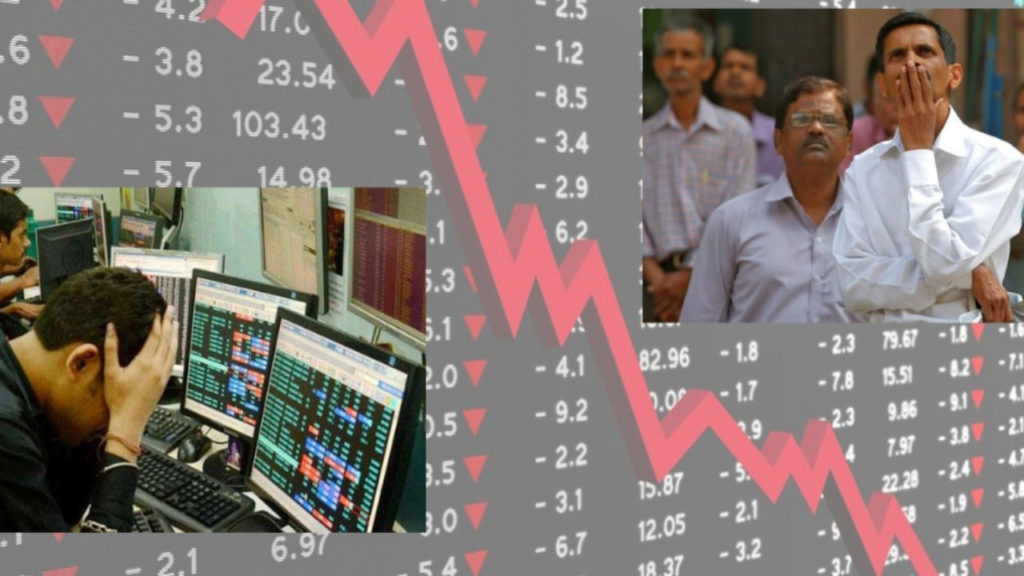#Coranavirus: Sensex Falls 3935 Points, Biggest Crash In History: 5 Reasons Why It Happened

#Coranavirus: Sensex Falls 3935 Points, Biggest Crash In History: 5 Reasons Why It Happened
India is under a lockdown, with businesses and companies shut down and domestic stocks on its knees.
The turmoil due to coronavirus, Indian stock markets witnessed its biggest single-day fall.
Nifty slipped to a four year low at 7,610.25, down 1,135 points while Sensex plunged down by 3935 points to 25,981, over three-year lows.
What are the reasons behind these crashes? Read to find out more
Contents
1. India under lockdown, Industries Shut Down
Maharashtra, Andhra Pradesh, Telangana, Punjab, Uttarakhand, Jharkhand, Jammu and Kashmir and Chandigarh are among the states and Union territories that have been completely brought under lockdown from March 22 till March 31. Leading automakers such as Tata Motors, Maruti Suzuki India, Mahindra & Mahindra, Force Motors, JCB, Mercedes-Benz, Hyundai have announced suspension of manufacturing activities across plants in Maharashtra and some other states. Two-wheeler makers Hero MotoCorp, Bajaj Auto have also suspended production across all manufacturing plants. Electronics maker LG said it will shut down two of its plants in India. The fear is that more such shutdowns are forecasted and these would bring the economic activity to a halt.
2. Asian Market Experiences Bashing
E-Mini futures for the S&P 500 shot down by 5% in the opening trades. The coronavirus cases in the US have escalated to 34,000 and over 400 fatalities were recorded, even as one in every three Americans have been told to stay home. In Asia, MSCI’s broadest index of Asia-Pacific shares outside Japan lost%, with South Korea badly hit. The commodity-heavy Australian market shed 5%.
3. The Halt on $1-trillion-plus Bill in US
The U.S. Senate’s direction to pass a $1-trillion-plus coronavirus response bill was halted on March 22, as Democrats held out for more money to help state and local governments and hospitals, while Republicans urged quick action to give financial markets a sign of encouragement. The measure failed to get the necessary 60 votes in the 100-member chamber to clear a procedural hurdle after days of negotiations, when 47 senators voted in favor and 47 opposed.
4.Rupee Hits Another Low
Already Foreign Portfolio Investments (FPIs) have pulled out over Rs 50,000 crore domestic equities in the last two weeks roughly.
The Rupee dropped to 76 level against the US dollar on March 23, raising fears of further foreign withdrawals.
IFA Global said in a note, “The reaction function of the central bank would be interesting to watch given that there is broad dollar strength. Another 2 per cent runaway move in USD-INR pair is on the cards in the absence of RBI intervention. Technical factors suggest the current bullish momentum to continue targeting 76 plus levels.”
5. Restrictions on Trading
On March 20 after trading continuously, the Sebi introduced additional measures to curb the volatility by introducing some restrictions in stocks futures and options trading. However, money managers think the actions won’t tamp down the wild fluctuations entirely. IIFL’s Ayon Mukhopadhyay told ET, “Sebi’s move to tighten short selling rules will affect a limited number of stocks at most, it will reduce volatility but not entirely. It is not a game changer in preventing short selling.”

Comments are closed, but trackbacks and pingbacks are open.